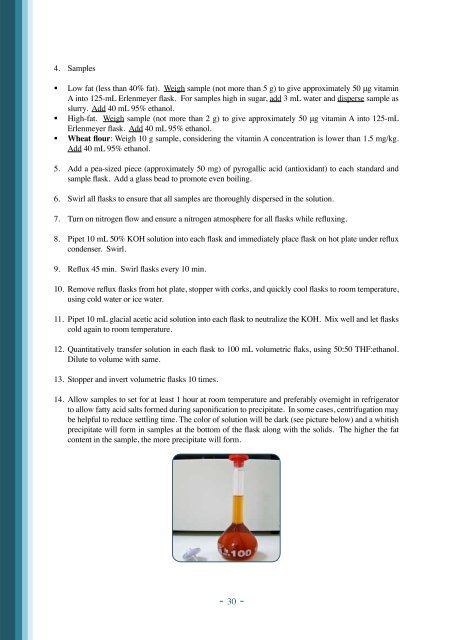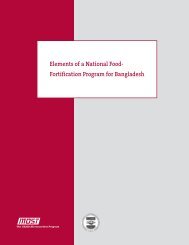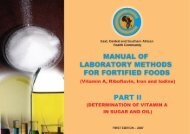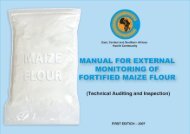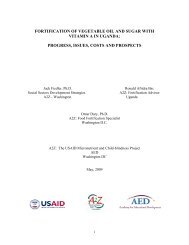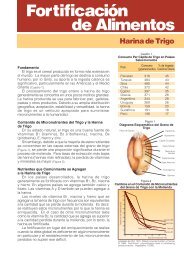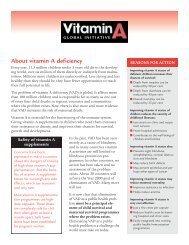manual of methods for determining micronutrients in fortified foods
manual of methods for determining micronutrients in fortified foods
manual of methods for determining micronutrients in fortified foods
You also want an ePaper? Increase the reach of your titles
YUMPU automatically turns print PDFs into web optimized ePapers that Google loves.
4. Samples<br />
• Low fat (less than 40% fat). Weigh sample (not more than 5 g) to give approximately 50 μg vitam<strong>in</strong><br />
A <strong>in</strong>to 125-mL Erlenmeyer flask. For samples high <strong>in</strong> sugar, add 3 mL water and disperse sample as<br />
slurry. Add 40 mL 95% ethanol.<br />
• High-fat. Weigh sample (not more than 2 g) to give approximately 50 μg vitam<strong>in</strong> A <strong>in</strong>to 125-mL<br />
Erlenmeyer flask. Add 40 mL 95% ethanol.<br />
• Wheat flour: Weigh 10 g sample, consider<strong>in</strong>g the vitam<strong>in</strong> A concentration is lower than 1.5 mg/kg.<br />
Add 40 mL 95% ethanol.<br />
5. Add a pea-sized piece (approximately 50 mg) <strong>of</strong> pyrogallic acid (antioxidant) to each standard and<br />
sample flask. Add a glass bead to promote even boil<strong>in</strong>g.<br />
6. Swirl all flasks to ensure that all samples are thoroughly dispersed <strong>in</strong> the solution.<br />
7. Turn on nitrogen flow and ensure a nitrogen atmosphere <strong>for</strong> all flasks while reflux<strong>in</strong>g.<br />
8. Pipet 10 mL 50% KOH solution <strong>in</strong>to each flask and immediately place flask on hot plate under reflux<br />
condenser. Swirl.<br />
9. Reflux 45 m<strong>in</strong>. Swirl flasks every 10 m<strong>in</strong>.<br />
10. Remove reflux flasks from hot plate, stopper with corks, and quickly cool flasks to room temperature,<br />
us<strong>in</strong>g cold water or ice water.<br />
11. Pipet 10 mL glacial acetic acid solution <strong>in</strong>to each flask to neutralize the KOH. Mix well and let flasks<br />
cold aga<strong>in</strong> to room temperature.<br />
12. Quantitatively transfer solution <strong>in</strong> each flask to 100 mL volumetric flaks, us<strong>in</strong>g 50:50 THF:ethanol.<br />
Dilute to volume with same.<br />
13. Stopper and <strong>in</strong>vert volumetric flasks 10 times.<br />
14. Allow samples to set <strong>for</strong> at least 1 hour at room temperature and preferably overnight <strong>in</strong> refrigerator<br />
to allow fatty acid salts <strong>for</strong>med dur<strong>in</strong>g saponification to precipitate. In some cases, centrifugation may<br />
be helpful to reduce settl<strong>in</strong>g time. The color <strong>of</strong> solution will be dark (see picture below) and a whitish<br />
precipitate will <strong>for</strong>m <strong>in</strong> samples at the bottom <strong>of</strong> the flask along with the solids. The higher the fat<br />
content <strong>in</strong> the sample, the more precipitate will <strong>for</strong>m.<br />
- 30 -


